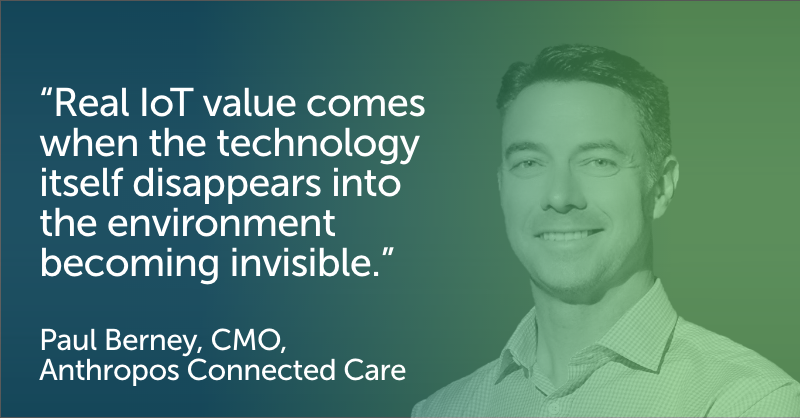Understanding the technology used in IoT and AI services can be hard at the best of times. In the first of a series of posts, our CMO Paul Berney takes a look at some of the challenges of building a Connected Care Platform and sets out our perspectives in a way any that doesn’t require a PhD in computing to understand.
The key idea behind of the Internet of Things (IoT), connecting devices and sensors to the Internet, is now commonplace.
But I believe that much of what people write and say about IoT is based on a fundamental misunderstanding about how IoT creates value. IoT value is not about the things that are connected, but about the connection to the internet itself.
A simple search for IoT will bring up hundreds, if not thousands of new devices that can be connected to the internet, from our fridges to our cars, to something as mundane as a toothbrush. The conversation is almost always about the Things because people find it easier to talk about and relate to the concrete.
Selling IoT emphasises ‘pretty things’ because this is what gets people excited and interested. People may even use the devices for a while, but device usage declines once the novelty wears off.

Real IoT value comes when the technology itself disappears into the environment becoming invisible and the focus switches to combining the measures (data) from the devices, sensors and actuators (i.e. the controls) that are connected together.
If you consider the most prominent IoT devices of today, like video enabled doorbells or home heating thermostats, there is a great temptation to add more and more functionality to the device. This focus on what consumers might want, leads to over-engineered Things that become complex to build and support.
A desire to increase the ’sparkle’ of Things drives faster development cycles, which, in turn, drives more bugs into the Things. Unfortunately, with limited management capability, the bugs are very expensive to fix (for example the Nest software update that took out many installations). ‘Thing’ makers can tolerate significant return rates for Things, as they are rewarded for growing the market quickly, rather than in delivering a continuing service.
This focus on end user functionality is often at the expense of management of the Thing itself. With such a model, it is the end user that becomes responsible for the service provided by the Things. That is really only attractive to an Early Adopter, not the Mass Market.
For the mass market, making the IoT disappear into the fabric of life crucially depends on two things; someone other than the user extracting any valuable data and turning that data into usable intelligence and the ability to remotely spot and fix problems – or at least prompting the user to fix them with ever-better tools. Without this remote care, an IoT service is not under control and insights and observations from it cannot be trusted.
I would argue therefore that the value in IoT is better delivered by taking away the focus on the device and instead shifting to providing a service through a subscription mode. In this approach, the economics depend more providing valuable intelligence to the user in a form that makes it actionable – possibly by other Things – and on the ability to manage the Things and the cost to identify and fix any issues as they arise.
It is worth remembering that physical hardware has a much longer life cycle than the software that interacts with it: say 1-10 years vs 1-50 weeks. You have only to think about the ongoing cost of upgrading your mobile phone versus the cost of upgrading the software on it. The former requires a considered buying decision, do we need the new functionality, will we even be able to tell the difference, is it worth the money?
Upgrading software merely requires us to click a button.
It makes more sense to have simpler Things and just change the software.
For these reasons, we have focussed on putting the intelligence into the platform, not in the Things connected to the Anthropos platform. We have built a platform that connects to almost any device using any means available. We know which devices are connected, if they are working as expected and if they are providing the data that is desired.
Follow Paul on LinkedIn and Twitter.